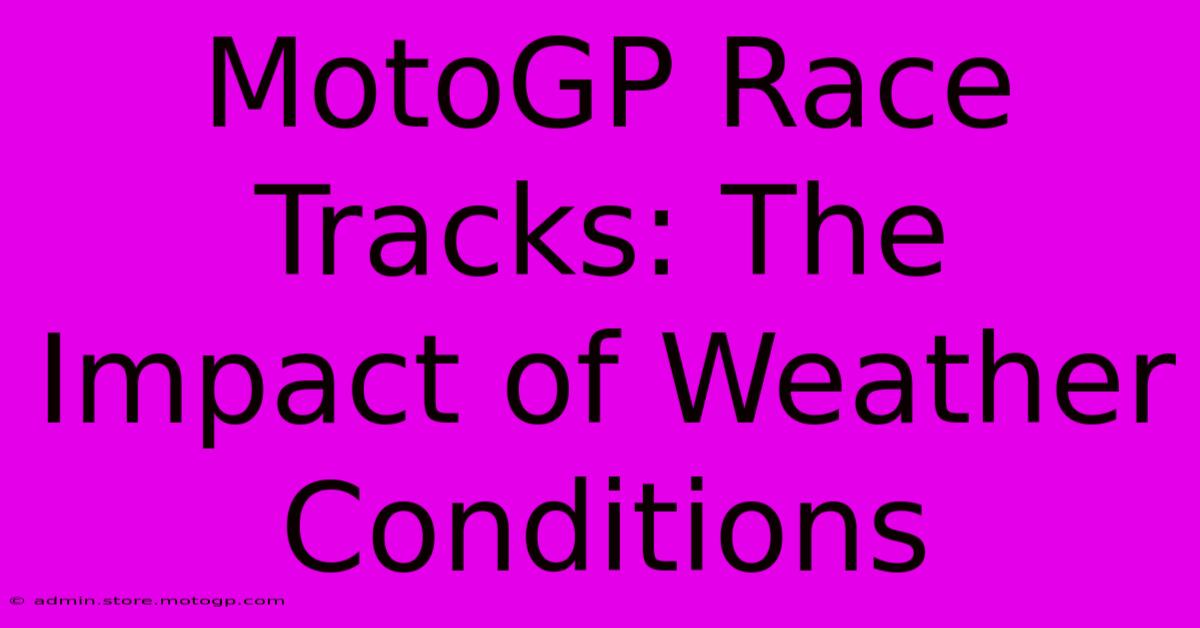MotoGP Race Tracks: The Impact Of Weather Conditions

Table of Contents
MotoGP Race Tracks: The Impact of Weather Conditions
MotoGP, the pinnacle of motorcycle racing, demands precision, skill, and nerves of steel from its riders. But even the most talented riders are at the mercy of a fickle opponent: the weather. The impact of weather conditions on MotoGP race tracks is immense, capable of transforming a seemingly straightforward race into a chaotic scramble for survival. This article delves into the significant influence of weather on MotoGP races, exploring how various conditions affect rider performance, race strategy, and ultimately, the outcome of the Grand Prix.
The Unpredictable Nature of Weather in MotoGP
MotoGP races are held across the globe, encompassing a diverse range of climates and weather patterns. From the scorching heat of Sepang in Malaysia to the unpredictable downpours of Silverstone in the UK, riders must adapt their riding style and strategies to a constantly changing environment. This unpredictable nature is a key element of the sport's challenge and excitement. A seemingly perfect day can turn sour in minutes, testing the riders' adaptability and the teams' ability to react swiftly.
The Impact of Different Weather Conditions:
-
Heat: Extreme heat significantly impacts rider fitness and bike performance. High temperatures can lead to dehydration and exhaustion, slowing reaction times and diminishing concentration. Engine performance can also be affected, leading to reduced power and increased tire wear. Races in hot climates often demand meticulous hydration strategies and careful tire management.
-
Rain: Rain transforms the track into a treacherous and unforgiving surface. Grip levels plummet, making cornering and braking extremely challenging. Aquaplaning becomes a significant risk, and visibility is often drastically reduced. Riders must adapt their riding styles, using different lines and employing more cautious braking techniques. The choice of wet-weather tires is also crucial, with teams constantly monitoring conditions to select the optimal rubber.
-
Wind: Strong winds can have a destabilizing effect on the motorcycles, particularly at high speeds. Gusts can buffet the bikes, making it difficult to maintain a stable line, especially on straights and during overtaking maneuvers. Wind conditions can also affect tire wear and fuel consumption.
-
Low Temperatures: Cold weather can negatively impact tire performance, making them less grippy and more susceptible to damage. Riders may struggle with reduced feeling in their hands and feet, impacting their control and precision. Cold temperatures can also affect engine performance and increase the risk of mechanical problems.
Strategies and Adaptations:
Teams and riders employ various strategies to cope with the challenges posed by fluctuating weather conditions. This includes:
-
Tire Selection: Choosing the right tires is paramount, particularly in unpredictable weather. Teams use detailed weather forecasts and trackside observations to determine the optimal tire compound and type.
-
Bike Setup: Bike setup plays a crucial role in handling different weather conditions. Suspension settings, aerodynamic adjustments, and engine mapping are all adjusted based on the prevailing weather.
-
Rider Technique: Experienced MotoGP riders possess exceptional adaptability, adjusting their riding style to suit the prevailing conditions. They use different braking points, cornering lines, and lean angles depending on the grip levels and track conditions.
-
Race Strategy: Weather conditions can significantly impact race strategy. Teams may choose to adopt a more cautious approach in wet conditions, focusing on consistency rather than aggressive overtaking.
The Human Element:
It's crucial to acknowledge the human element in the equation. The mental strength and adaptability of riders are tested to their limits when facing challenging weather conditions. Making split-second decisions under pressure, while managing the physical demands of racing in adverse conditions, separates the champions from the rest.
Conclusion:
Weather plays a pivotal role in the excitement and unpredictability of MotoGP races. Its influence extends beyond simple challenges; it dictates strategies, affects rider performance, and can completely reshape the outcome of a Grand Prix. Understanding the impact of different weather conditions on MotoGP race tracks is crucial to appreciating the complexity, skill, and bravery involved in this thrilling motorsport.

Thank you for visiting our website wich cover about MotoGP Race Tracks: The Impact Of Weather Conditions. We hope the information provided has been useful to you. Feel free to contact us if you have any questions or need further assistance. See you next time and dont miss to bookmark.
Featured Posts
-
Tnt Sports Your Source For Moto Gp News And Analysis
Feb 20, 2025
-
Accident Moto Gp How Riders Learn From Mistakes
Feb 20, 2025
-
Cota Store Shop Official Cota Apparel And Accessories
Feb 20, 2025
-
Us Gp Sprint The Evolution Of The Sprint Race
Feb 20, 2025
-
Club Si Austin F1 Where Passion Meets Performance
Feb 20, 2025
